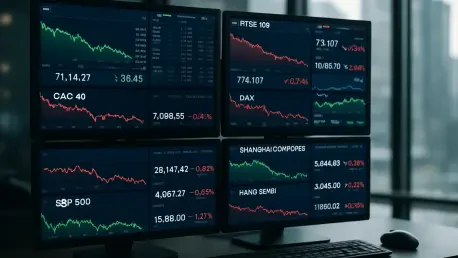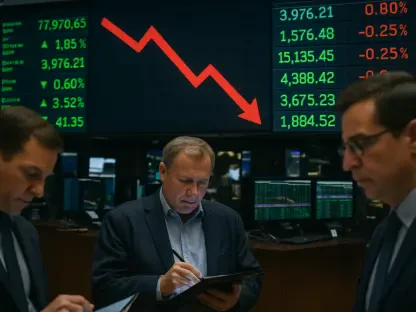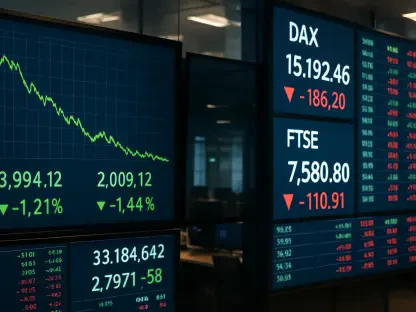What happens when a single company’s performance can ignite a firestorm of optimism across the globe, turning uncertainty into unbridled enthusiasm? On November 20, 2024, Nvidia, a titan in the tech world, unleashed earnings that didn’t just meet expectations—they obliterated them, forecasting quarterly revenue far beyond Wall Street predictions. This seismic event didn’t merely mark a win for one corporation; it became a beacon of hope for investors worldwide, especially in tech-heavy markets, proving that artificial intelligence (AI) is no fleeting trend but a cornerstone of future growth. The ripple effects were felt from Tokyo to New York, as stock indices soared and fears of an AI valuation bubble began to fade.
This story isn’t just about numbers on a balance sheet; it’s about the profound influence of technology on global economic stability. Nvidia’s success has redefined market sentiment, offering a lifeline to industries and investors betting on AI’s transformative power. The following sections delve into how this earnings report sparked a worldwide rally, why it matters to every corner of the financial landscape, and what steps can be taken to navigate the opportunities and challenges it presents.
A Tech Titan Ignites a Market Surge
Nvidia’s earnings announcement on that pivotal November day acted as a catalyst, setting off a chain reaction of confidence across global markets. With revenue projections shattering analyst estimates, the company didn’t just report growth—it signaled robust demand for AI chips from major cloud providers, as emphasized by CEO Jensen Huang. This wasn’t merely a corporate milestone; it was a moment that shifted the narrative around tech investments, proving that the sector could still deliver staggering returns.
The immediate impact was electric, particularly in tech-centric regions hungry for positive news. Markets that had been jittery over potential overvaluation in AI stocks found renewed vigor, as Nvidia’s performance became a symbol of resilience. Investors who had been on edge suddenly saw a path forward, with the company’s results acting as a counterargument to months of skepticism about the sustainability of tech-driven gains.
This surge wasn’t confined to a single exchange or time zone; it became a global phenomenon almost overnight. The energy from Nvidia’s report fueled buying sprees in key financial hubs, demonstrating how interconnected modern markets have become. As a result, the tech giant’s triumph laid the groundwork for a broader discussion on the role of innovation in driving economic momentum.
Why Nvidia’s Performance Matters to Everyone
Beyond the immediate market reaction, Nvidia’s earnings hold significance for a wide array of stakeholders, from individual investors to policymakers tracking economic trends. As a leading manufacturer of AI chips, the company sits at the epicenter of a technological revolution touching industries as diverse as healthcare, automotive, and cloud computing. Its success serves as a barometer for the health of these sectors, signaling whether the heavy investments in AI are paying off.
The implications extend far beyond corporate boardrooms, influencing global economic outlooks. For markets in Asia, Europe, and the Americas, Nvidia’s results provide a lens through which to gauge the viability of tech as a long-term growth engine. Investors in every region are keenly aware that a stumble by such a pivotal player could dampen enthusiasm for innovation, while continued strength offers reassurance amid broader financial uncertainties.
Moreover, the company’s performance ties directly into debates about market stability and valuation risks. With AI stocks often criticized for inflated prices, Nvidia’s ability to deliver concrete results offers a counterpoint to naysayers, suggesting that the hype around artificial intelligence might be grounded in real potential. This dynamic makes its earnings a critical data point for anyone with a stake in the future of technology.
Unpacking the Global Market Rally
The aftermath of Nvidia’s earnings report saw a spectacular rally unfold, with Asian markets leading the charge in a display of unbridled optimism. Japan’s Nikkei 225 skyrocketed by 4.2%, while South Korea’s Kospi climbed 3.3%, and Taiwan’s market surged 3.4%, driven by gains in AI supply chain giants like TSMC and Samsung Electronics. These numbers reflect not just a regional boom but a collective sigh of relief among investors who had feared a tech bubble bursting.
While the Asian tech boom painted a picture of euphoria, the rally also highlighted disparities across different geographies. China, for instance, remained a notable outlier, with benchmark lending rates unchanged and fading hopes for economic stimulus casting a shadow over its markets. This contrast underscores how Nvidia’s influence, while powerful, couldn’t uniformly lift every economy, revealing deeper structural challenges in certain regions.
A key factor in this global upswing was the alleviation of fears surrounding AI overvaluation. Prior sell-offs tied to concerns about unsustainable stock prices reversed course as Nvidia’s numbers provided hard evidence of demand and profitability. This shift in sentiment has positioned AI as a credible driver of long-term growth, encouraging investors to rethink strategies and embrace the sector’s potential with renewed confidence.
Voices from the Market: Expert Insights and Investor Sentiment
As the markets reacted, analysts and strategists weighed in, offering perspectives that added depth to the unfolding story. Tony Sycamore from IG in Sydney described Nvidia’s performance as a “master class in AI dominance,” capturing the bullish mood that swept through financial circles. Such commentary reinforced the idea that the company’s results were not just a fluke but a defining moment for the tech industry.
However, not all voices echoed unreserved optimism, with some experts pointing to broader economic headwinds. Gavin Friend of National Australia Bank cautioned about a “data fog” surrounding U.S. economic indicators, suggesting that uncertainties around Federal Reserve policy could temper enthusiasm. This balanced viewpoint highlights the complexity of the current financial landscape, where tech triumphs coexist with lingering concerns about interest rates and inflation.
Investor sentiment, meanwhile, mirrored this blend of excitement and caution. While many rushed to capitalize on the tech rally, others remained wary of potential pitfalls, such as delayed U.S. jobs data impacting market expectations. These diverse opinions paint a vivid picture of a market at a crossroads, buoyed by Nvidia’s success yet mindful of the broader challenges that lie ahead.
Navigating the Broader Economic Landscape: What Investors Can Do
Despite the wave of positivity sparked by Nvidia’s earnings, the global financial environment remains fraught with complexities that demand careful navigation. Uncertainties like delayed U.S. jobs reports and ambiguity around Fed policy decisions continue to loom large, potentially influencing market trajectories beyond the tech sector. Currency fluctuations, such as the weakening Japanese yen, further complicate the picture for international investors.
For those looking to act on the momentum, several strategies can help balance opportunity with risk. Keeping a close watch on upcoming U.S. economic data and Fed announcements is crucial, as these will likely shape broader market sentiment in the near term. Staying informed about these indicators can provide a clearer sense of whether the current rally has lasting power or faces potential disruptions.
Diversification also emerges as a vital approach, with a focus on balancing investments between high-growth regions like Asian tech hubs and more cautious markets such as China. Additionally, targeting opportunities within the AI supply chain, inspired by Nvidia’s lead, can offer growth potential, though vigilance around valuation risks remains essential. These practical steps empower investors to harness the current optimism while preparing for any unexpected shifts in the economic terrain.
Looking back, Nvidia’s earnings report stood as a turning point that galvanized global stock markets, offering a much-needed boost to investor confidence in AI and technology. The rally that followed, especially in Asia, marked a historic moment of relief from valuation fears. Yet, the journey was not without its challenges, as regional disparities and economic uncertainties in the U.S. and beyond tempered the euphoria. Reflecting on this period, the key takeaway was the need for adaptability—investors who thrived were those who seized the moment while building safeguards against volatility. Moving forward, the focus should remain on tracking pivotal data releases and diversifying portfolios to sustain momentum, ensuring that the lessons from this remarkable chapter continue to guide financial strategies in an ever-evolving world.









